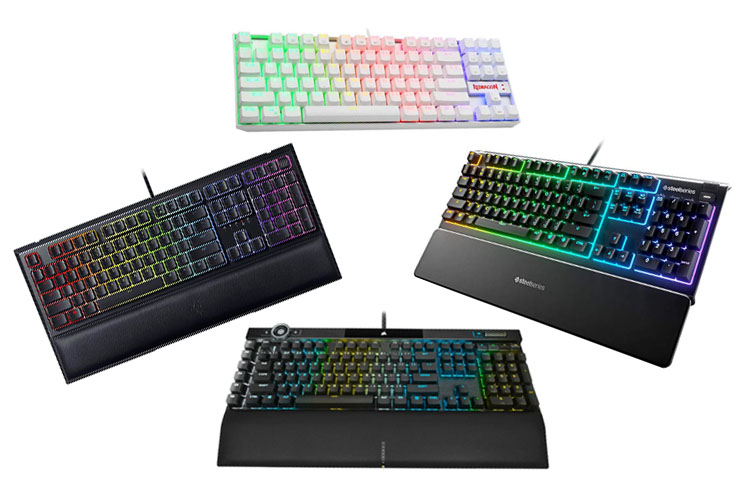
Keyboard manufacturers often include marketing terms such as anti-ghosting in the packaging of their keyboards. Even before mechanical keyboards became popular, anti-ghosting was a big selling point for gaming keyboards. However, many users are still not aware of what it means.
Ghosting occurs when you press multiple keys simultaneously, and your other keys fail to register. Ghosting can be a real problem for gamers who must press multiple keys simultaneously. An anti-Ghosting keyboard function addresses this problem allowing users to press several keys at the same time and have all of the keystrokes register correctly.
To further add to the confusion, the terms anti-ghosting and N-Key Rollover (NKRO) are interchanged often. So the question is, what is Anti-ghosting, and why does it matter?
In this article, we will be aiming to answer that question. We will also be differentiating it with NKRO to help users fully grasp whether Anti-ghosting is a necessary feature or just a marketing gimmick.
Ghosting in Keyboards, Defined
Before we dive into Anti-ghosting, let us first discuss keyboard ghosting. Ghosting in keyboards is a phenomenon that occurs when multiple keys are pressed simultaneously on a keyboard. When ghosting occurs, some of the pressed keys are not registered despite the keys being properly actuated.
This may not seem like an issue for regular users, and after all, most users rarely have to actuate multiple keys simultaneously. However, ghosting can become a big problem for more demanding tasks requiring multiple key combinations.
For instance, gamers constantly press multiple keys at the same time. Some genres, such as fighting games, require precise inputs. If one of the player’s key presses does not register, that could easily make the player lose the round or the entire game. This is the reason why so many gaming keyboards heavily advertise their anti-ghosting features.
Ghost Inputs
Our previous definition is how keyboard manufacturers use the term. However, this definition is incorrect. Ghosting is traditionally referred to as having ghost inputs. In a nutshell, ghost inputs happen when a key actuates without being pressed by the user. For instance, if the user pressed multiple keys at once, an unrelated key that the user did not press can register on the screen.
However, this definition of ghosting is no longer used. This is because computer keyboards have advanced so much that ghost inputs have become rare. So for this article, we will be using the definition that manufacturers use for ghosting.
Causes of Ghosting in Keyboards

There are three possible causes of ghosting in keyboards: the lack of proper hardware to process the signals of the keyboards, dirt/debris underneath the keycaps, and the lack of proper software support for multiple key presses. First off, many keyboard manufacturers choose to use cheaper components inside the PCB. Naturally, the result would have several limitations in the features present and the maximum number of key presses accepted.
Another reason is dirty and debris under the keycaps. This is quite common, especially since many gamers eat snacks in front of their keyboards. And when gunk accumulates underneath the keycaps, the keys become unresponsive.
Lastly, the communication protocol between the hardware and software may limit the maximum number of simultaneous keys reported. However, it is unlikely for this to be the case with modern computer OS.
Keyboard Rollover

Manufacturers have acknowledged that ghosting is an issue for casual and serious keyboard users. Their answer to this problem is to implement rollover in keyboards. Rollover is a hardware function that allows users to accept a specific number of inputs.
Keyboard manufacturers then used the term N-key Rollover to denote how many keys a keyboard can accept. They also introduced the term anti-ghosting, which we will be discussing next.
Defining Anti-Ghosting in Keyboards

Anti-ghosting is very similar to the function of NKRO. It aims to solve keyboard ghosting by allowing multiple user keystrokes to register. The difference between NKRO and Anti-ghosting lies in their implementation.
NKRO is almost exclusively used for mechanical keyboards because of their superior components. And depending on the keyboard model, some mechanical keyboards can even allow full NKRO throughout the entire keyboard.
On the other hand, anti-ghosting is a feature that is not exclusive to mechanical keyboards, and because anti-ghosting is more limited than NKRO, it’s only applied in certain areas, such as the WASD keys. Essentially, this means that keyboard manufacturers guarantee that the essential parts of the keyboard will register their keystrokes without fail.
Is Anti-Ghosting an Important Feature?
Despite not being quite as advanced as full NKRO support, Anti-ghosting is still a crucial feature to have. This is because manufacturers will be able to implement the benefits of NKRO in a wide range of keyboards.
Budget gaming keyboards, for instance, utilize rubber-dome switches. And as we have discussed earlier, switches based on membrane switches will not have the same accuracy or capacity to implement NKRO. But with Anti-ghosting technology, even membrane keyboard-based devices will still work decently.
In addition, Anti-ghosting can also be applied with laptop keyboards/Chiclet keyboards. This is great since not all laptop brands can accommodate mechanical keyboards. It also assures gamers can play competitive matches without resorting to using an external keyboard.



